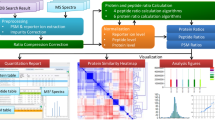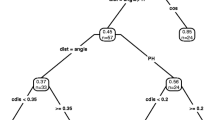Abstract
Spectral counting has become a widely used approach for measuring and comparing protein abundance in label-free shotgun proteomics. However, when analyzing complex samples, the ambiguity of matching between peptides and proteins greatly affects the assessment of peptide and protein inventories, differentiation, and quantification. Meanwhile, the configuration of database searching algorithms that assign peptides to MS/MS spectra may produce different results in comparative proteomic analysis. Here, we present three strategies to improve comparative proteomics through spectral counting. We show that comparing spectral counts for peptide groups rather than for protein groups forestalls problems introduced by shared peptides. We demonstrate the advantage and flexibility of this new method in two datasets. We present four models to combine four popular search engines that lead to significant gains in spectral counting differentiation. Among these models, we demonstrate a powerful vote counting model that scales well for multiple search engines. We also show that semi-tryptic searching outperforms tryptic searching for comparative proteomics. Overall, these techniques considerably improve protein differentiation on the basis of spectral count tables.




Similar content being viewed by others
Abbreviations
- FP:
-
False positive
- MM:
-
Myrimatch
- SQ:
-
Sequest
- TP:
-
True positive
- TR:
-
TagRecon
- XT:
-
X!Tandem
References
Eng JK, McCormack AL, Yates JR (1994) An approach to correlate tandem mass-spectral data of peptides with amino acid sequences in a protein database. J Am Soc Mass Spectrom 5:976–989
Perkins DN, Pappin DJ, Creasy DM, Cottrell JS (1999) Probability-based protein identification by searching sequence databases using mass spectrometry data. Electrophoresis 20(18):3551–3567
Craig R, Beavis RC (2004) TANDEM: matching proteins with tandem mass spectra. Bioinforma 20(9):1466–1467
Zhang B, Chambers MC, Tabb DL (2007) Proteomic parsimony through bipartite graph analysis improves accuracy and transparency. J Proteome Res 6(9):3549–3557
Kall L, Storey JD, MacCoss MJ, Noble WS (2008) Assigning significance to peptides identified by tandem mass spectrometry using decoy databases. J Proteome Res 7(1):29–34
Yang X, Dondeti V, Dezube R, Maynard DM, Geer LY, Epstein J, Chen X, Markey SP, Kowalak JA (2004) DBParser: web-based software for shotgun proteomic data analyses. J Proteome Res 3(5):1002–1008
Elias JE, Gygi SP (2007) Target-decoy search strategy for increased confidence in large-scale protein identifications by mass spectrometry. Nat Methods 4(3):207–214
Choi H, Ghosh D, Nesvizhskii AI (2008) Statistical validation of peptide identifications in large-scale proteomics using the target-decoy database search strategy and flexible mixture modeling. J Proteome Res 7(1):286–292
Ma ZQ, Dasari S, Chambers MC, Litton MD, Sobecki SM, Zimmerman LJ, Halvey PJ, Schilling B, Drake PM, Gibson BW, Tabb DL (2009) IDPicker 2.0: improved protein assembly with high discrimination peptide identification filtering. J Proteome Res 8(8):3872–3881
Liu H, Sadygov RG, Yates JR 3rd (2004) A model for random sampling and estimation of relative protein abundance in shotgun proteomics. Anal Chem 76(14):4193–4201
Zybailov B, Coleman MK, Florens L, Washburn MP (2005) Correlation of relative abundance ratios derived from peptide ion chromatograms and spectrum counting for quantitative proteomic analysis using stable isotope labeling. Anal Chem 77(19):6218–6224
Fu X, Gharib SA, Green PS, Aitken ML, Frazer DA, Park DR, Vaisar T, Heinecke JW (2008) Spectral index for assessment of differential protein expression in shotgun proteomics. J Proteome Res 7(3):845–854
Fermin D, Basrur V, Yocum AK, Nesvizhskii AI (2011) Abacus: a computational tool for extracting and pre-processing spectral count data for label-free quantitative proteomic analysis. Proteome 11(7):1340–1345
Jin S, Daly DS, Springer DL, Miller JH (2008) The effects of shared peptides on protein quantitation in label-free proteomics by LC/MS/MS. J Proteome Res 7(1):164–169
Nesvizhskii AI, Keller A, Kolker E, Aebersold R (2003) A statistical model for identifying proteins by tandem mass spectrometry. Anal Chem 75(17):4646–4658
Keshishian H, Addona T, Burgess M, Kuhn E, Carr SA (2007) Quantitative, multiplexed assays for low abundance proteins in plasma by targeted mass spectrometry and stable isotope dilution. Mol Cell Proteomics 6(12):2212–2229
Tabb DL, Vega-Montoto L, Rudnick PA, Variyath AM, Ham AJ, Bunk DM, Kilpatrick LE, Billheimer DD, Blackman RK, Cardasis HL, Carr SA, Clauser KR, Jaffe JD, Kowalski KA, Neubert TA, Regnier FE, Schilling B, Tegeler TJ, Wang M, Wang P, Whiteaker JR, Zimmerman LJ, Fisher SJ, Gibson BW, Kinsinger CR, Mesri M, Rodriguez H, Stein SE, Tempst P, Paulovich AG, Liebler DC, Spiegelman C (2010) Repeatability and reproducibility in proteomic identifications by liquid chromatography-tandem mass spectrometry. J Proteome Res 9(2):761–776
Picotti P, Aebersold R, Domon B (2007) The implications of proteolytic background for shotgun proteomics. Mol Cell Proteomics 6(9):1589–1598
Jones AR, Siepen JA, Hubbard SJ, Paton NW (2009) Improving sensitivity in proteome studies by analysis of false discovery rates for multiple search engines. Proteome 9(5):1220–1229
Searle BC, Turner M, Nesvizhskii AI (2008) Improving sensitivity by probabilistically combining results from multiple MS/MS search methodologies. J Proteome Res 7(1):245–253
Kwon T, Choi H, Vogel C, Nesvizhskii AI, Marcotte EM (2011) MSblender: a probabilistic approach for integrating peptide identifications from multiple database search engines. J Proteome Res 10(7):2949–2958
Li M, Gray W, Zhang H, Chung CH, Billheimer D, Yarbrough WG, Liebler DC, Shyr Y, Slebos RJ (2010) Comparative shotgun proteomics using spectral count data and quasi-likelihood modeling. J Proteome Res 9(8):4295–4305
Halvey PJ, Zhang B, Coffey RJ, Liebler DC, Slebos RJ (2012) Proteomic consequences of a single gene mutation in a colorectal cancer model. J Proteome Res 11(2):1184–1195
Kessner D, Chambers M, Burke R, Agus D, Mallick P (2008) ProteoWizard: open source software for rapid proteomics tools development. Bioinforma 24(21):2534–2536
Dasari S, Chambers MC, Slebos RJ, Zimmerman LJ, Ham AJ, Tabb DL (2010) TagRecon: high-throughput mutation identification through sequence tagging. J Proteome Res 9(4):1716–1726
Tabb DL, Fernando CG, Chambers MC (2007) MyriMatch: highly accurate tandem mass spectral peptide identification by multivariate hypergeometric analysis. J Proteome Res 6(2):654–661
Ma ZQ, Tabb DL, Burden J, Chambers MC, Cox MB, Cantrell MJ, Ham AJ, Litton MD, Oreto MR, Schultz WC, Sobecki SM, Tsui TY, Wernke GR, Liebler DC (2011) Supporting tool suite for production proteomics. Bioinforma 27(22):3214–3215
Benjamini Y, Drai D, Elmer G, Kafkafi N, Golani I (2001) Controlling the false discovery rate in behavior genetics research. Behav Brain Res 125(1–2):279–284
Pyne S, Futcher B, Skiena S (2006) Meta-analysis based on control of false discovery rate: combining yeast ChIP-chip datasets. Bioinforma 22(20):2516–2522
Whitlock MC (2005) Combining probability from independent tests: the weighted Z-method is superior to Fisher's approach. J Evol Biol 18(5):1368–1373
Stouffer SA, Suchman EA, DeVinney LC, Star SA, Williams RM Jr (1949) The American soldier: adjustment during army life. Princeton University Press, Princeton
Rhodes DR, Yu J, Shanker K, Deshpande N, Varambally R, Ghosh D, Barrette T, Pandey A, Chinnaiyan AM (2004) Large-scale meta-analysis of cancer microarray data identifies common transcriptional profiles of neoplastic transformation and progression. Proc Natl Acad Sci U S A 101(25):9309–9314
Edwards N, Wu X, Tseng C-W (2009) An unsupervised, model-free, machine-learning combiner for peptide identifications from tandem mass spectra. Clin Proteonomics 5(1):23–36
Sanchez-Tillo E, Lazaro A, Torrent R, Cuatrecasas M, Vaquero EC, Castells A, Engel P, Postigo A (2010) ZEB1 represses E-cadherin and induces an EMT by recruiting the SWI/SNF chromatin-remodeling protein BRG1. Oncogene 29(24):3490–3500
Wan D, Gong Y, Qin W, Zhang P, Li J, Wei L, Zhou X, Li H, Qiu X, Zhong F, He L, Yu J, Yao G, Jiang H, Qian L, Yu Y, Shu H, Chen X, Xu H, Guo M, Pan Z, Chen Y, Ge C, Yang S, Gu J (2004) Large-scale cDNA transfection screening for genes related to cancer development and progression. Proc Natl Acad Sci U S A 101(44):15724–15729
Keller A, Nesvizhskii AI, Kolker E, Aebersold R (2002) Empirical statistical model to estimate the accuracy of peptide identifications made by MS/MS and database search. Anal Chem 74(20):5383–5392
Acknowledgments
D. L. Tabb and Y.-Y. Chen were supported by U01 CA152647 from the National Cancer Institute. S. Dasari, Z.-Q. Ma, and L. J. Vega-Montoto were supported by R01 CA126218 from the National Cancer Institute.
Author information
Authors and Affiliations
Corresponding author
Additional information
Published in the topical issue Quantitative Mass Spectrometry in Proteomics with guest editors Bernhard Kuster and Marcus Bantscheff.
Electronic supplementary material
Below is the link to the electronic supplementary material.
ESM 1
(PDF 1.30 MB)
Rights and permissions
About this article
Cite this article
Chen, YY., Dasari, S., Ma, ZQ. et al. Refining comparative proteomics by spectral counting to account for shared peptides and multiple search engines. Anal Bioanal Chem 404, 1115–1125 (2012). https://doi.org/10.1007/s00216-012-6011-x
Received:
Revised:
Accepted:
Published:
Issue Date:
DOI: https://doi.org/10.1007/s00216-012-6011-x




